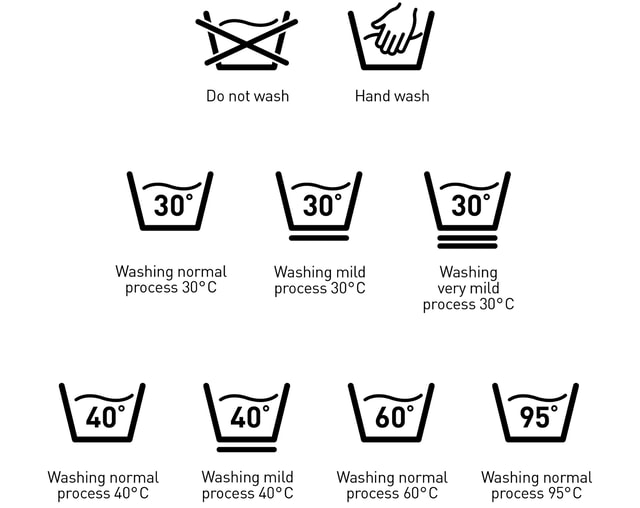Laundry symbols & their meaning: What the signs on the care label reveal
Do you have problems interpreting the symbols on the care labels in your laundry? While the handwash symbol and the correct temperature are quite self-explanatory, the other laundry symbols are more like hieroglyphics from times long gone. To prevent accidents when caring for your laundry, we explain all the signs for washing, drying, ironing, bleaching, and dry cleaning.
by CALIDA
September 22, 2023•6 min reading time

Practical tips and instructions for your textile care.
Table of Contents
Which wash cycle is the right one?
The correct wash cycle is symbolised by the small tub on the care label. If the tub is crossed out, it means that you should not wash your clothes at all. In this case, they are usually one-off fabrics or materials that you can hang out in the fresh air to freshen up.
In general: If a laundry symbol is crossed out, you should not carry out the respective care program. Accordingly, a crossed-out circle in a square means “do not tumble dry”, a crossed-out iron means “do not iron”, and a crossed-out triangle means “do not bleach”.

The right washing temperature
You can easily read off the maximum washing temperature of your laundry from the number shown in the small water tray on the care label. While 30 °C or 40 °C normally applies to normal clothes, you can usually wash towels, underwear, and socks at 60 °C or on the boil wash cycle at 95 °C.
Gentle wash cycle (easy care)
The gentle wash cycle is also called “easy care”. You can recognise it by a line under the small laundry tub on the care label. In most cases, delicate fabrics, such as baby clothes, bridal underwear or lingerie with lace, should be washed on the gentle wash cycle.
Special gentle wash cycle (delicates)
You can tell that your laundry should be washed as delicates or wool in the special gentle wash cycle by the two lines under the laundry tub. This wash cycle is characterised by temperatures of maximum 40 °C and a very low number of revolutions of your washing machine. You use it on wool, silk, or other delicate fabrics.
Hand wash
The hand wash symbol is absolutely self-explanatory as it depicts a hand in the small laundry tub of the laundry label. Hand washing is characterised by very low temperatures of maximum 30 °C and is always needed when even the special gentle wash cycle of your washing machine is unsuitable for delicate textiles.
Textile care tips
Care symbols and useful tips at a glance
Please turn inside out!
Washing clothing inside out protects colours and surfaces.
No fabric conditioner
Do not use fabric conditioner for delicate micromodal underwear as this will cause the fibres to stick together. Fabric conditioner also reduces the radiance of wool and silk clothing, which means that it ist better to use a shampoo.
Grey tinge?
Have your whites developed a grey tinge over time? Use a detergent for curtains to turn them sparkling white again. White linen can turn yellow if exposed to too strong or excessive sunlight and should therefore be dried in the shade.
Beware of limescale!
If your favourite pyjamas suddenly feel hard, it may be that limescale has settled on the fibres. A descaling tablet or a dash of vinegar essence in the last rinse cycle removes the limescale from the washing and keeps your washing machine running smoothly. And don't worry, the smell will go away.
Careful washing
Do not select a higher temperature than the one shown on the care label. Washing at too high temperature damages the fibres and fit. Low washing temperatures protect the environment and save money.
How do I dry my laundry?
The correct drying of your laundry is always indicated on the care label by the symbols inside the small square, which is usually next to the laundry symbol for the correct wash cycle. We tell you what the drying symbols mean.

In the drum dryer
You can tell if you can dry your laundry in the dryer by the square that contains a circle. But there are different variants: Two dots in this laundry symbol indicate that you may dry the laundry normally, i.e. also at high temperatures. One dot, on the other hand, means that you should dry your laundry gently in the dryer, i.e. at lower temperatures and with fewer revolutions.
Dry lying down
You can tell that you should dry your laundry lying down by the horizontal line in the square. This is important, for example, for textiles with a special drape.
Dry on the line
If there is a vertical line in the square of the laundry label, this indicates that the laundry has to dry on the clothesline. This is usually the case when your laundry is not allowed in the dryer.
Dry dripping wet
If the square on the care label contains a vertical or horizontal line, your laundry usually comes straight from the washing machine and has already been spun. Two lines on top of each other or next to each other, on the other hand, mean that you should dry your laundry when it is dripping wet. This is the case, for example, after hand washing or when you turn off the spin cycle of your washing machine.
Dry in the shade
Some textiles do not tolerate direct sunlight, as the sun can cause warm temperatures and also has a bleaching effect. If one of the drying symbols mentioned above contains a horizontal stripe in the upper left corner, your laundry should be dried in the shade or indoors.
Can I iron my clothes?
You can tell if you can iron your clothes by the iron on the laundry label. If it is crossed out, the laundry usually is made of fine, crease-free textiles that should not be ironed. An iron symbol with two small lines crossed out below it indicates that you must not steam iron your laundry.

The right ironing temperature
The temperatures at which you can iron your laundry are shown by the dots inside the iron symbol. At one dot, the iron should be set to the lowest temperature setting, two dots mean moderate temperatures up to 150 °C, and at three dots, you may also iron your laundry hot, i.e. at temperatures up to 200 °C.
Bleach laundry: Yes or no?
The triangle symbol on the laundry label tells you whether and how you can bleach your laundry. If the triangle is crossed out with an X, it means, as with all other laundry symbols: Do not bleach! A triangle without content shows that all types of bleaching are possible.

Oxygen bleach
If your laundry is suitable for oxygen bleaching, this is indicated by two parallel lines running inside the triangle from bottom left to top right.
Bleaching with chlorine
If the triangle symbol on the care label contains the letter combination CL, you may bleach your laundry with chlorine-containing agents.
What should be considered for dry cleaning symbols?
The laundry symbols for dry cleaning are particularly important for employees in a laundry. They are indicated by the circle symbol on the care label. An F indicates treatment with hydrocarbons, an A permits cleaning with solvents, and the letter P stands for perchloroethylene.
Of interest for you is usually only the circle with a W. If this laundry symbol is crossed out, your clothes should not be wet-cleaned A trip to the laundry would therefore be indispensable to have stains professionally removed!

Discover more interesting blog posts:


